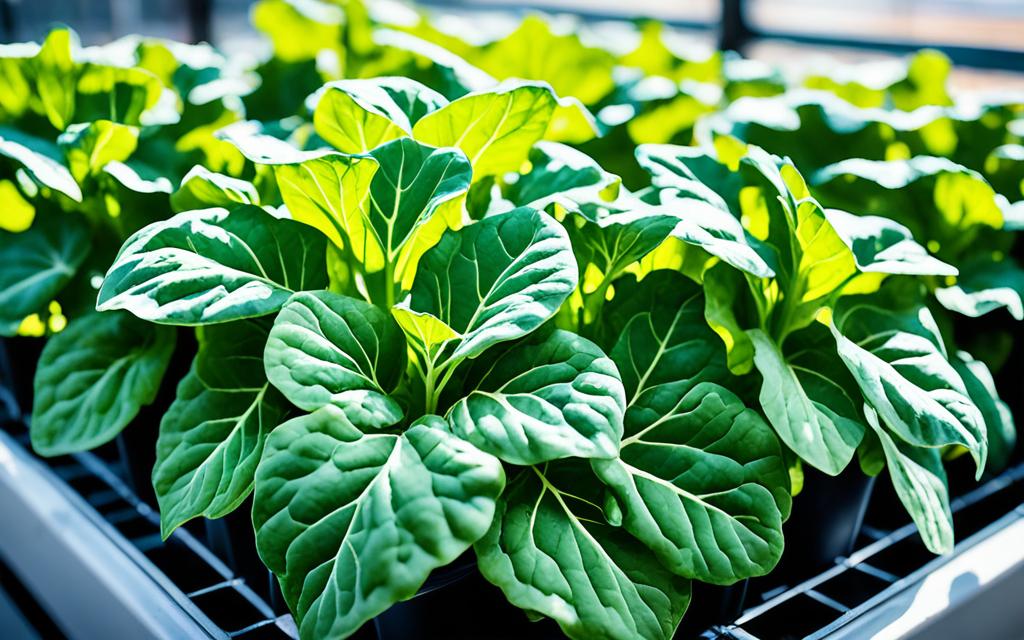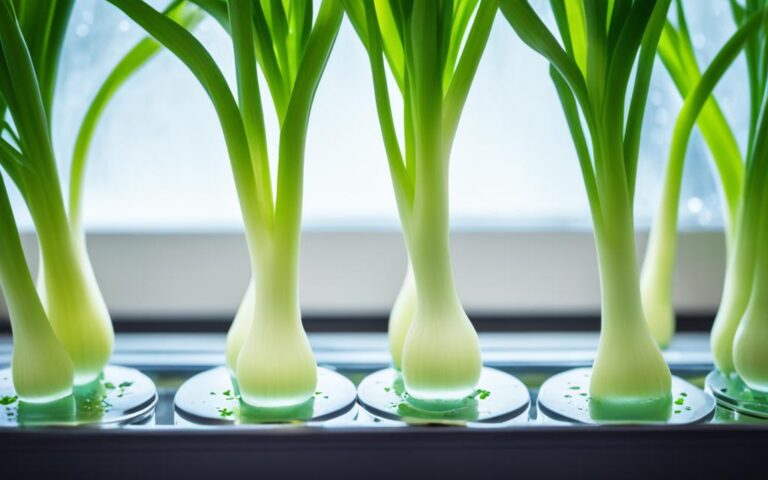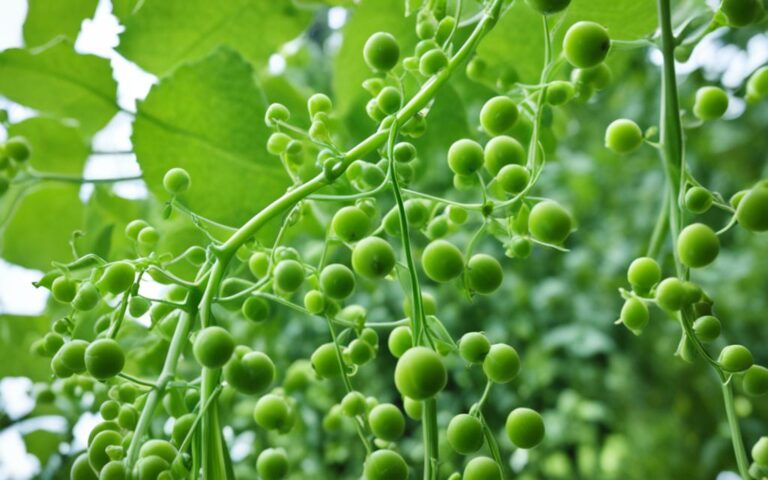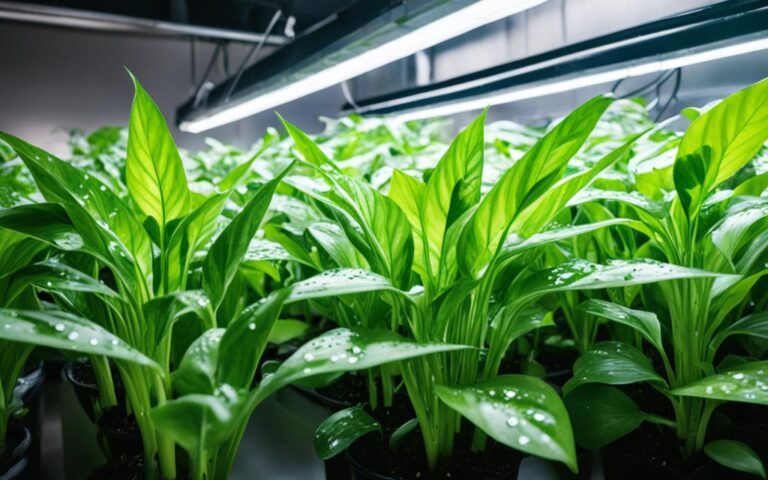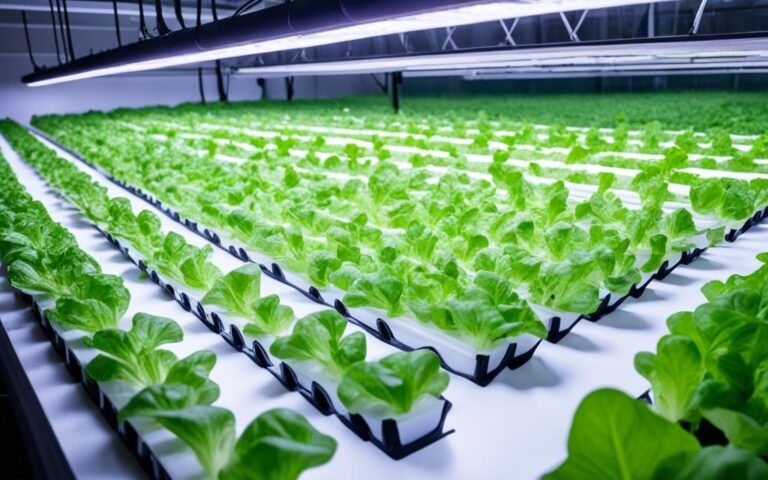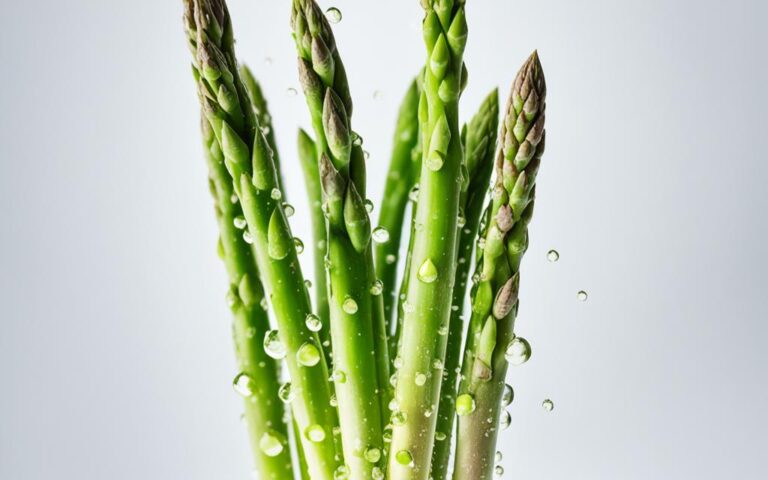Grow Fresh Hydroponic Collard Greens at Home
Did you know a single acre of hydroponic collard greens can produce up to 25,000 pounds? This shows how powerful hydroponic growing can be, even at home. Collard greens are a Southern favorite, full of vitamins, minerals, and antioxidants. They’re a great addition to a healthy diet.
In this guide, we’ll show you how to grow fresh, tasty collard greens hydroponically. You’ll learn to enjoy this versatile crop all year long.
Key Takeaways
- Hydroponic collard greens offer a year-round, space-efficient way to grow this nutrient-dense superfood at home.
- Proper seed selection, germination requirements, and choice of hydroponic system are crucial for successful collard green cultivation.
- Maintaining optimal growing conditions, including pH, EC, light, and temperature, is essential for thriving collard green plants.
- Effective nutrient management and reservoir maintenance ensure the plants receive the necessary nutrients for robust growth.
- Vigilance in pest and disease management, along with proper harvesting techniques, helps maximize yield and productivity.
Introduction to Hydroponic Collard Greens
Growing collard greens hydroponically lets you have fresh, nutrient-rich greens all year. It doesn’t matter if you’re growing them indoors or outdoors. Hydroponic gardening is great for these leafy veggies. It lets you control their environment and get more from your plants.
Hydroponic Collard Greens: An Easy Indoor and Outdoor Grow Guide
Collard greens do well in hydroponic systems, whether inside or outside. They fit many hydroponic setups, like wick systems, DWC, and NFT. With the right care, you can pick tender, tasty collard greens from your home.
Benefits of Growing Hydroponic Collard Greens at Home
- Consistent, year-round production of fresh, nutrient-dense collard greens
- Efficient use of water and space, making it ideal for small-scale or indoor growing
- Faster growth and higher yields compared to traditional soil-based gardening
- Precise control over growing conditions, such as pH, temperature, and nutrient levels, for optimal plant health
- Reduced risk of pests and diseases, thanks to the contained, soil-free environment
By using the benefits of hydroponic collard greens, you get a steady supply of these healthy greens. You also save time, water, and space in your gardening.

Starting Collard Greens from Seeds
Growing collard greens from seeds is rewarding and lets you control your hydroponic garden. You can start seeds indoors or directly outdoors. It’s important to know about collard greens seed selection, germination, and transplanting for a good harvest.
Seed Selection and Quality
Choosing high-quality, disease-resistant collard green seeds is key for a thriving hydroponic crop. Pick seeds from trusted suppliers and choose varieties that do well in controlled environments. Make sure seeds are fresh and haven’t passed their expiration date. Old seeds may not germinate as well.
Starting Seeds Indoors vs. Outdoors
- Starting collard greens indoors: Plant seeds 5-6 weeks before the last frost in your area. This gives them a head start and lets you control their growing conditions.
- Direct sowing outdoors: If your climate allows, you can plant collard green seeds directly in your hydroponic system or garden. Keep the soil at 45-85°F for best germination, which takes 4-7 days.
Germination Requirements
Collard greens need a specific temperature for germination. Keep the growing medium at 45-85°F, indoors or outdoors. It’s also important to keep the soil moist but not too wet or dry.
“Paying attention to the details of seed selection, germination, and transplanting will set your collard greens up for a productive and bountiful harvest.”
Hydroponic Systems for Collard Greens
Collard greens do well in many hydroponic systems. Each system has its own benefits for home growers. From the easy-to-use wick system to the fast-growing deep water culture (DWC), there’s a system for everyone.
Wick System
The wick system is great for beginners. It’s easy to set up and maintain. A wick pulls nutrient-rich water from a reservoir to the plant’s roots.
Deep Water Culture (DWC)
If you want fast growth and lots of oxygen, try the deep water culture (DWC) system. The plant’s roots are in a nutrient-rich solution. This means constant oxygen and nutrients for the best growth.
Ebb and Flow (Flood and Drain)
The ebb and flow system floods the growing tray and then drains it. This cycle gives the roots the right amount of nutrients and oxygen.
Nutrient Film Technique (NFT)
The nutrient film technique (NFT) has a steady flow of nutrients over the roots. It doesn’t need a growing medium. This means plants get the nutrients they need without extra effort.
Drip System
The drip system delivers nutrients directly to the roots. It does so slowly and efficiently. This method cuts down on waste and makes sure plants use water and nutrients well.
Aeroponics
Aeroponics is great for misting roots efficiently. The system suspends roots in the air and mists them with nutrients. This gives plants lots of oxygen and nutrients.
Choosing a hydroponic system for collard greens depends on space, budget, and how much control you want. Each system has its own benefits. This lets gardeners pick the best setup for their needs.
Growing Conditions for hydroponic Collard Greens
To grow healthy hydroponic collard greens, you need to pay attention to several key factors. These include the right pH and EC levels, as well as the amount of light and temperature. Each of these elements is vital for the greens’ health and how quickly they grow.
pH and EC Requirements
Collard greens do best in a pH of 6.5 to 7.5. This range helps them absorb nutrients well and stay healthy. The EC level should be between 1.6 to 2.5 mS/cm. This balance is crucial for strong growth and development.
Light and Temperature Needs
These greens need 6 to 8 hours of sunlight daily or 12 to 16 hours under grow lights. Keep the air temperature between 45°F and 85°F. The nutrient solution should be at 68°F to 72°F.
Time to Maturity
With the right care, hydroponic collard greens can be ready to eat in 65 to 85 days. This quick growth means you can harvest them several times a year. They are a great choice for indoor or outdoor hydroponic setups.
“Proper management of growing conditions is key to cultivating thriving hydroponic collard greens that are packed with nutrients and flavor.”
Nutrient Management
Proper nutrient management is key to growing healthy hydroponic collard greens. These greens need a mix of essential nutrients to do well without soil. By knowing what collard greens need, growers can make sure their plants get the right food for growth and plenty of leaves.
Essential Nutrients for Collard Greens
Hydroponic collard greens need nitrogen (N), phosphorus (P), and potassium (K) the most. These nutrients help with growth, strong roots, and plant health. They also need calcium (Ca), magnesium (Mg), and micronutrients like iron, boron, and manganese for health and balance.
Fertilizer Preparation for Hydroponic Collard Greens
For collard greens in hydroponics, use a fertilizer made for leafy greens with about 150 ppm nitrogen. Mix the fertilizer with water, making sure the pH and EC levels are right for growth. Keep an eye on the nutrient solution and adjust it as needed to keep the plants thriving.
| Nutrient | Function | Optimal Range |
|---|---|---|
| Nitrogen (N) | Supports foliage growth and development | 150 ppm |
| Phosphorus (P) | Promotes root growth and overall plant vigor | 30-60 ppm |
| Potassium (K) | Enhances disease resistance and stress tolerance | 150-250 ppm |
| Calcium (Ca) | Strengthens cell walls and helps prevent blossom end rot | 100-200 ppm |
| Magnesium (Mg) | Plays a role in chlorophyll production and photosynthesis | 30-60 ppm |
Reservoir and System Maintenance
Keeping the hydroponic system’s reservoir in good shape is key to growing healthy hydroponic collard greens. You need to check and adjust the pH and electrical conductivity (EC) levels often. This makes sure the plants get the right mix of nutrients.
It’s vital to clean the reservoir now and then and change the nutrient solution. This stops algae, bacteria, or other bad stuff from growing. It helps your hydroponic collard greens stay healthy and grow well.
Checking and Adjusting pH and EC Levels
Collard greens do best in a slightly acidic setting. The ideal pH is between 6.0 and 6.5. Testing the pH and adjusting it with pH up or down is key for good nutrient uptake and plant health.
Also, keep an eye on the EC levels. They should be between 1.5 to 2.5 mS/cm. This ensures your hydroponic collard greens get the right amount of nutrients like nitrogen, phosphorus, and potassium.
Cleaning and Changing the Nutrient Solution
- Clean the reservoir every 2-4 weeks to get rid of algae, bacteria, or other bad stuff.
- Change the nutrient solution every 1-2 weeks to keep it fresh and full of nutrients. This also stops toxins or imbalances from building up.
- Make sure to disinfect things like tubing and grow trays to keep the growing area clean and healthy.
By focusing on hydroponic collard greens reservoir maintenance and hydroponic collard greens system maintenance, you can help your plants do great. You’ll get lots of fresh, healthy collard greens right at home.
Pests and Disease Management
Hydroponic systems help control the environment, but collard greens can still face pests and diseases. It’s important to act early to keep your hydroponic collard greens healthy and productive.
Common Pests and Diseases
Aphids, thrips, and spider mites are common pests that can harm hydroponic collard greens. They eat the leaves and stems, causing plants to grow poorly and produce less. Collard greens can also get fungal diseases like downy mildew and Pythium root rot. These diseases can weaken the plants and hurt their health.
Preventive Measures
There are steps you can take to reduce the risk of pests and diseases in hydroponic collard greens. Keeping the growing conditions right, like the pH, temperature, and humidity, can keep pests away. Watching your plants closely and catching problems early is key to managing them well.
Using beneficial insects, like ladybugs or lacewings, can help control pests naturally. If pests get worse, you might need to use organic pesticides or fungicides. Always follow the instructions on the product carefully.
By taking these steps, you can make your hydroponic collard greens healthier and more productive. This ensures a good harvest all season long.
Harvesting Hydroponic Collard Greens
Growing your own hydroponic collard greens is rewarding. Knowing when and how to harvest them is key for quality and yield. By understanding the best harvest time and proper techniques, you can have fresh, nutrient-rich greens all year.
Identifying Harvest Time
Collard greens are ready to harvest 65-85 days after seeding, depending on the conditions. Look for large, dark green leaves that are firm and perfect. Use these signs to know when to start harvesting.
Proper Harvesting Techniques
Harvesting hydroponic collard greens requires care. Cut the leaves at the base with a sharp knife or scissors, leaving 4-6 inches of stem. This lets the plant keep growing, giving you more greens over time. Be gentle to avoid bruising or tearing the leaves, which can affect their freshness and shelf life.
| Harvesting Tips | Explanation |
|---|---|
| Timing | Collard greens are typically ready to harvest 65-85 days after seeding. |
| Visual Cues | Look for large, dark green leaves that are firm and free of damage or defects. |
| Cutting Technique | Use a sharp knife or scissors to cut the leaves at the base of the plant, leaving 4-6 inches of stem attached. |
| Handling | Handle the greens gently to avoid bruising or tearing the leaves. |
Follow these tips for when to harvest hydroponic collard greens and how to do it right. You’ll enjoy a bountiful and tasty harvest from your hydroponic garden.
Maximizing Yield and Productivity
To get the most out of your hydroponic collard greens, make sure you provide the best growing conditions. This means keeping the right pH, electrical conductivity (EC), light, and temperature levels. These factors are key for healthy growth.
Tips for Optimal Growth
- Keep the pH between 6.0 and 6.8 for the best nutrient uptake.
- Make sure the EC is between 2.0 and 3.5 mS/cm, based on the plant’s growth stage.
- Give your collard greens 12 to 14 hours of top-notch, full-spectrum light daily.
- Keep the temperature steady between 65°F and 75°F (18°C and 24°C) for the best growth.
Crop Rotation and Succession Planting
Using crop rotation and succession planting can boost your hydroponic collard greens’ yield and productivity. Crop rotation stops pests and diseases from spreading. Succession planting lets you have multiple harvests, giving you fresh greens all year.
- Switch your collard greens with other Brassica family members like kale or cabbage to break up pest and disease cycles.
- Plant your collard greens at different times, spaced 2-4 weeks apart, for a steady supply of fresh greens.
By focusing on the right growing conditions and using crop rotation and succession planting, you can maximize the yield and productivity of your hydroponic collard greens. This way, you’ll have a plentiful harvest all year.
Advantages of Hydroponic Collard Greens
Growing collard greens hydroponically has many benefits over traditional farming. It lets you have year-round hydroponic collard greens. This means you always have fresh, nutritious greens, no matter the weather. You can control the growing conditions, making it possible to have water efficient hydroponic collard greens and space efficient hydroponic collard greens.
Hydroponics can use up to 90% less water than traditional farming. This makes it great for those who care about water. Plus, you can grow more greens in less space with hydroponics. This is perfect for gardeners with limited space in cities or small areas.
Year-Round Production
Hydroponics lets you keep the perfect growing conditions for collard greens all year. This means you can have a steady supply of year-round hydroponic collard greens. Even in places with tough weather or changing seasons.
Water and Space Efficiency
Hydroponics is known for being water efficient and space efficient. It recycles water, cutting down water use by up to 90% compared to traditional farming. Also, you can grow more greens in less space with hydroponics. This is great for gardeners in cities or with small gardens.
“Hydroponic systems offer the perfect solution for growing fresh, nutrient-rich collard greens year-round, while using a fraction of the water and space required by soil-based methods.”
Conclusion
Growing hydroponic collard greens is a great way to have fresh, healthy greens all year. This guide has shown how to grow these greens using hydroponic systems. It covers everything from picking the right seeds to harvesting your greens.
There are many benefits to growing hydroponic collard greens. You can grow them all year and save water and space. This method lets you control the growing conditions and doesn’t need soil. It’s a green way to add more fresh, homegrown food to your diet.
If you’re new to gardening or already love hydroponics, this guide has what you need. It gives you the knowledge and tools to grow collard greens at home. By growing your own hydroponic collard greens, you can enjoy nutritious food and help the planet.
